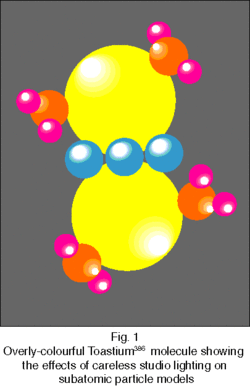Double Butter Theory
Murphy's Law states:
| “ | If something can go wrong, it will | ” |
And Finagle's Corollary gives us:
| “ | If you throw a slice of toast with butter into the air, it will always fall with the buttered side down | ” |
Finally, the Law of Cat Conservation states:
| “ | A cat will always land on its foots. | ” |
Double Butter Theory is a refinement of the well understood Cat-Toast Device (see Murphy's law application for antigravitatory cats).
It was Oscar Wilde who first tied a piece of buttered toast to the back of a cat and then dropped it from the top of the Leaning Tower of Pizza. The cat-toast amalgam fell at the constant acceleration of gravity until it stopped to hover just above the ground. Both substances wanted to hit the ground first but cancelled each other out.
In the standard model the cat-toast hybrid revolves round the components' common axis trying to achieve equilibrium. If harnessed, this rotation could provide a cheap, limitless (though possibly noisy) energy source.
The Double Butter Theory deviates from the standard model in that it obviates the cat. Theoretically a piece of toast (or any other toastlike or quasi-toastlike substance), spread with "equal" amounts of butter on both sides would achieve the same result without the need to hide the experiments from animal welfare organisations, feed the cat, or deal with the obvious problems inherent in having cats poop while revolving at phenomenally high speeds.
Practical obstacles[edit | edit source]
The main difficulty experienced with experimenters in this field is the problem of getting exactly equal amounts of butter on each side of the toast. Any discrepancy between the quantities of butter applied and the toast merely falls on the side with the most butter.
The obvious path that experimenters have taken is to use small slices of toast with carefully weighed butter portions applied evenly to both sides, simultaneously to minimize volatility. (Usually butter is frozen to near Absolute Zero using liquid nitrogen, then precisely sliced used a very very small bacon slicer before application). Even these work-arounds have carried a margin of error so large as to make any practical application unworkable.
Future developments[edit | edit source]
Experiments are scheduled for the winter of 2010 at CERN's Large Hardon Collider in Switzerland in which two simultaneous streams of buttermilk ions will be fired at toast particles less than three molecules in size.[1] (Three toast molecules is the theoretical limit for a slice; anything smaller behaves not as toast but as a crumb which, obviously, has no sides and therefore is, by its very nature, unbutterable in any meaningful sense.) If successful, the first practical working cat-free anti-gravity device could be built within seven years.
Protests against these experiments have been made by many who fear the remote (but theoretically possible) chance that the experiment will lead to an uncontrollable chain reaction forming the creation of a so-called Brown Hole and the release of vast quantities of dangerous subatomic radiation - mostly in the form of the theoretical Hinks Bo'sun, Hardon, and Ineverpromisedyouarosegardon particles.
Fears that the activation of the Large Hardon Collider will mean an irreparable rending of the space-time continuum, the end of all life on earth, and the cancellation of several important sporting fixtures were dismissed by CERN as, "The sort of thing killjoys would say when given the opportunity to blow up something really big."
Double Butter Theory in fiction[edit | edit source]
Many hard Science Fiction writers have jumped on the DBT (and some of the namby-pamby ones too when the hard ones let them near the ideas bucket). Most notably the theory was explained in mind numbing detail by David Niven in his famous Ringworld A Go-Go (aka Hoola-Hoops of the Gods') in which Lois Wooo, the hero of the previous fifteen increasingly tedious novels, returns in a revolutionary new ship powered by the equally revolutionary Toastatic Drive, to the mysterious Ringworld of the title.
Recent developments[edit | edit source]
Early in the year 2012, archaeologists off the coast of Spain discovered an ancient scroll which suggested that Sir William Gray of Lewistown first contemplated such a theory. Unfortunately, due to the Great Butter Drought of '57, it would be centuries before the experiment could properly take place, though a margin notation in one of Leonardo DaVinci's sketches of a "flying machine" suggest that he too considered using his fabulous machine to test a cat-toast device.
Feetnote[edit | edit source]
- ↑ Probably molecules of toastium-386. Apart from being the most stable of all the transtoastatic atoms, it is the tastiest.

